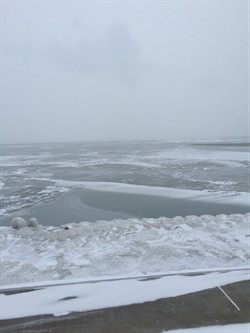 At the crack of dawn, Saturday morning, found Sarah and I in a flurry of activity. After hobbling together a breakfast of scrambled eggs (devouring them with tortilla chips, as all the utensils had already been packed), we scrambled to finish the packing and cleaning so we could make it downtown before noon.
At the crack of dawn, Saturday morning, found Sarah and I in a flurry of activity. After hobbling together a breakfast of scrambled eggs (devouring them with tortilla chips, as all the utensils had already been packed), we scrambled to finish the packing and cleaning so we could make it downtown before noon.
Being rather idiosyncratic about my schedules, I had every leg of the trip accounted for and planned out. As I was weaving the 16-foot truck through traffic as though it were a compact car, I allowed myself a smug grin when I noticed we were ahead of schedule. However, I failed to foresee how exhausting it would be to lug everything up the winding, narrow stairwell to our attic nest. It would have been near impossible without the generous help we received from our school-friend Jawad, and his girlfriend, Michela.
It is no surprise that the soul of our profession, which emphasizes connection and personalized healthcare guidance, would be made manifest in the students one meets here at National University. As a whole, the student body is engaged, genuine, and passionate about helping others. There is a diversity of perspective and a tangible air of expressive individualism that lends to the unique atmosphere that fills the halls.
I have always thought that one of the greatest strengths inherent to Chiropractic Medicine is the back-story of each student and practitioner. Many people find their way to National University after deciding that their old career wasn’t fulfilling their passions. Others find their way here directly after college. The unique mixture of experience and points-of-view truly enhances the learning environment, enabling students to gain an understanding of people from all walks of life.
 This is what I reflected on as I ran through the snow along the lake the following day. It was 8 degrees, but my heart was warm with thankfulness. It had been a busy week, between moving and two exams: Medical Microbiology and Respiratory Physiology; yet I had conquered the daunting to-do list and come out the other end unscathed.
This is what I reflected on as I ran through the snow along the lake the following day. It was 8 degrees, but my heart was warm with thankfulness. It had been a busy week, between moving and two exams: Medical Microbiology and Respiratory Physiology; yet I had conquered the daunting to-do list and come out the other end unscathed.
I came to a greater appreciation of Dr. Robert Appleyard‘s copious notes detailing every aspect of respiration as my breath created clouds of CO2 in the frigid air. At a few points I really had to keep reminding myself that an increase in ventilation is practically always enough to match metabolism and perfusion. A working knowledge of how the human body works to interact with the environment and maintain homeostasis is a truly beautiful thing. Learning the function of an organ system and the pathologies that negatively affect that function is the first step in learning to restore function.
Staring out across the ice, I felt truly grateful that I had chosen a school with such a firm foundation in the sciences.




0 Comments